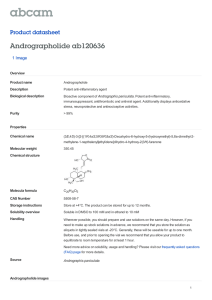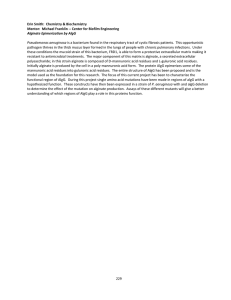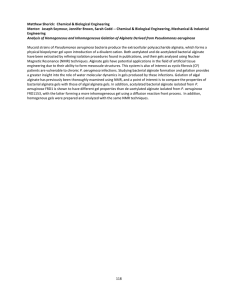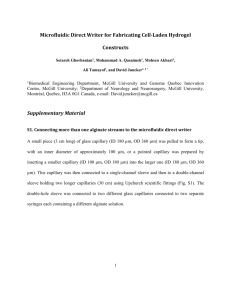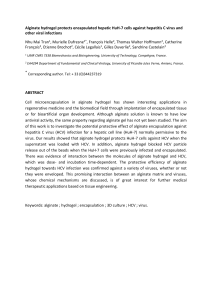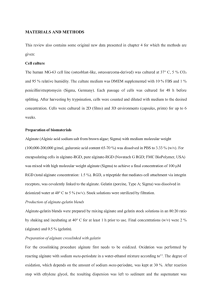Document 13772480
advertisement
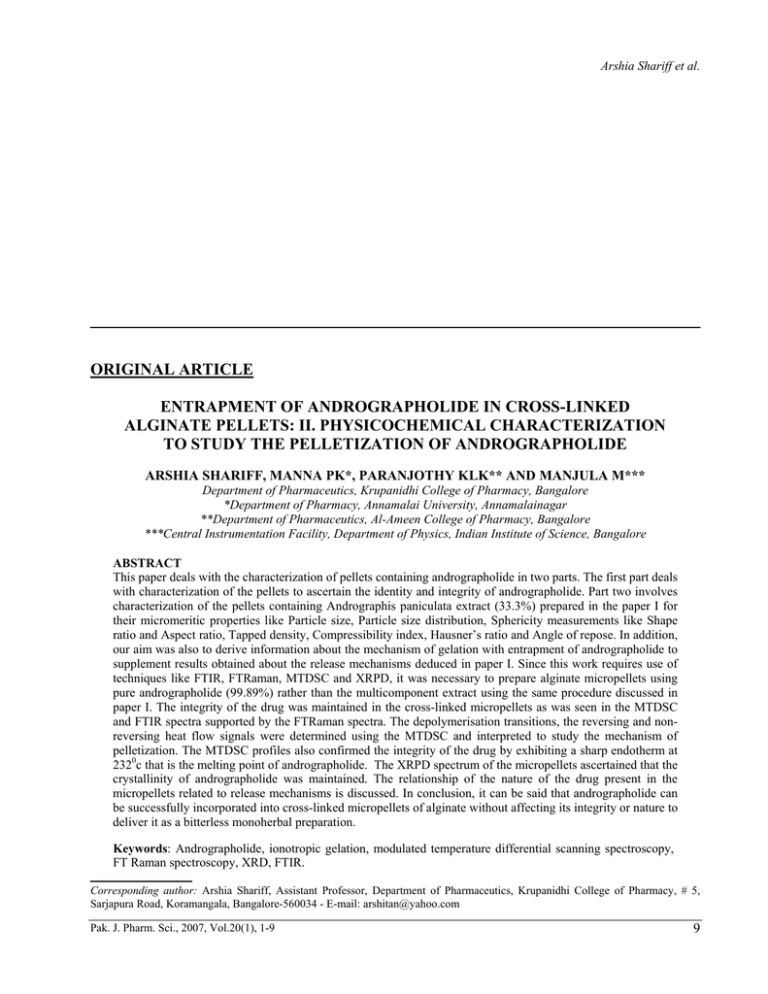
Arshia Shariff et al.
drug release from calcium alginate micropellets is quite
complex demonstrating various mechanisms like
diffusion, relaxation and erosion simultaneously.
REFERENCES
Catherine Kuo K and Peter ma X (2001). Ionically crosslinked alginate hydrogels as scaffolds for tissue
engineering: Part 1. Structure, gelation rate and
mechanical properties. Biomaterials, 22: 511-21.
Hubbell JA (1996). Hydrogel systems for barriers and
local drug delivery in the control of wound healing. J.
Controlled. Release, 39: 305-13.
Indian Herbal Pharmacopoeia, (2002). Indian Drug
Manufacturers Association, Mumbai, Revised edition,
pp.57-69.
Iruin A, Fernandez-Arevalo M, Alvarez-Fuentes J, Fini A
and Holgado MA (2005). Elaboration and “in vitro”
characterization of 5-ASA beads. Drug Dev. Ind.
Pharm., 31(2): 231-9.
Roland B and Ornlaksana P (1989). Spherical
agglomerates of Water-insoluble drugs. J. Pharm. Sci.,
78(11): 964-7.
Sellassie IG (1989). Pharmaceutical Pelletization
Technology. Marcel Dekker Inc., New York, 37: 1-12.
Shoaib HM, Tazeen J, Merchant HA and Yousuf RI
(2006). Evaluation of drug release kinetics from
Ibuprofen matrix tablets using HPMC. Pak. J. Pharm.
Sci., 19(2): 119-24.
Received: 22-11-2006 – Accepted: 17-02-2007
ORIGINAL ARTICLE
ENTRAPMENT OF ANDROGRAPHOLIDE IN CROSS-LINKED
ALGINATE PELLETS: II. PHYSICOCHEMICAL CHARACTERIZATION
TO STUDY THE PELLETIZATION OF ANDROGRAPHOLIDE
ARSHIA SHARIFF, MANNA PK*, PARANJOTHY KLK** AND MANJULA M***
Department of Pharmaceutics, Krupanidhi College of Pharmacy, Bangalore
*Department of Pharmacy, Annamalai University, Annamalainagar
**Department of Pharmaceutics, Al-Ameen College of Pharmacy, Bangalore
***Central Instrumentation Facility, Department of Physics, Indian Institute of Science, Bangalore
ABSTRACT
This paper deals with the characterization of pellets containing andrographolide in two parts. The first part deals
with characterization of the pellets to ascertain the identity and integrity of andrographolide. Part two involves
characterization of the pellets containing Andrographis paniculata extract (33.3%) prepared in the paper I for
their micromeritic properties like Particle size, Particle size distribution, Sphericity measurements like Shape
ratio and Aspect ratio, Tapped density, Compressibility index, Hausner’s ratio and Angle of repose. In addition,
our aim was also to derive information about the mechanism of gelation with entrapment of andrographolide to
supplement results obtained about the release mechanisms deduced in paper I. Since this work requires use of
techniques like FTIR, FTRaman, MTDSC and XRPD, it was necessary to prepare alginate micropellets using
pure andrographolide (99.89%) rather than the multicomponent extract using the same procedure discussed in
paper I. The integrity of the drug was maintained in the cross-linked micropellets as was seen in the MTDSC
and FTIR spectra supported by the FTRaman spectra. The depolymerisation transitions, the reversing and nonreversing heat flow signals were determined using the MTDSC and interpreted to study the mechanism of
pelletization. The MTDSC profiles also confirmed the integrity of the drug by exhibiting a sharp endotherm at
2320c that is the melting point of andrographolide. The XRPD spectrum of the micropellets ascertained that the
crystallinity of andrographolide was maintained. The relationship of the nature of the drug present in the
micropellets related to release mechanisms is discussed. In conclusion, it can be said that andrographolide can
be successfully incorporated into cross-linked micropellets of alginate without affecting its integrity or nature to
deliver it as a bitterless monoherbal preparation.
Keywords: Andrographolide, ionotropic gelation, modulated temperature differential scanning spectroscopy,
FT Raman spectroscopy, XRD, FTIR.
Corresponding author: Arshia Shariff, Assistant Professor, Department of Pharmaceutics, Krupanidhi College of Pharmacy, # 5,
Sarjapura Road, Koramangala, Bangalore-560034 - E-mail: arshitan@yahoo.com
Pak. J. Pharm. Sci., 2007, Vol.20(1), 1-9
9
Entrapment of andrographolide in cross-linked alginate pellets
INTRODUCTION
Micropellets of alginate formed by cross-linking of
alginate with a counter ion like calcium is best described
by the “Egg-Box” model (Grant et al., 1973). The specific
binding of divalent cations to a polysaccharide
polyelectolyte like sodium alginate will lead to firm
cohesion between the chains. The buckled chain of
alginate is suggested as a two-dimensional analogue of a
corrugated egg-box with interstices in which the cations
may be packed and get coordinated. It was found
necessary to confirm the presence and integrity of
andrographolide that gets entrapped during the process of
co-operative mechanism of binding of the alginate chains.
Further the characterization of the physical and
micromeritic properties can be utilized as in process
control parameters for reproducibility of the micropellets
during their manufacture. In this study, a
multidisciplinary approach to pellet characterization has
been employed by the use of vibrational spectroscopy
(FTIR and FTRaman), XRPD and MTDSC. Raman and
FTIR cannot only be used to confirm the integrity of the
drug but also to study the polymers with different degrees
of crystallinity. A number of bands are found with
changed intensities as the degree of crystallinity changes.
Regions of higher crystallinity exhibit sharpened Raman
bands with lower band-width (Scranton et al., 2005).
XRD profiles are basically used to study crystalline
compounds. Amorphous samples can also be clearly
confirmed for their nature from the XRPD profiles. XRD
patterns that differ in appearance need not necessarily
represent different crystalline forms because these
patterns are affected by sample size and sample
preparation. MTDSC profiles can not only be used as a
tool in drug-polymer interaction studies by identifying the
characteristic melting point endotherm but can also be
used to study the mechanism of pelletization or gelation
of the polymers (Pillay and Fassihi, 1999).
MATERIALS AND METHODS
All the materials listed under materials and methods of
paper I were used. Formulations and the manufacturing
procedures produced in paper I were used for the
evaluation of the micromeritic properties.
Fourier transform infra-red spectroscopy (FTIR)
IR transmission spectra were obtained using a FTIR
spectrophotometer (FTIR-8300, Shimadzu, JAPAN). A
total of 5% (w/w) of sample, with respect to the
potassium bromide (KBr) disc was mixed with dry
KBr.The mixture was ground into a fine powder using an
agate mortar before compressing into KBr disc under a
hydraulic press at 10,000 psi. Each KBr disc was scanned
at 4mm/s at a resolution of 2cm over a wave number
region of 400-4500cm-1. The characteristic peaks were
recorded using the software Shimadzu FTIR 8000 SCS.
10
Fourier transform Raman spectroscopy (FTRaman)
Raman spectra were obtained using a BRUKER
FTRaman spectrophotometer (model RFF100) with a
resolution of 4cm-1, an excitation wavelength of
1064nm,laser intensity of 100-mwatt and accumulation
time of 30 minutes.
Modulated temperature differential scanning
calorimetry (MTDSC)
One of the most classic applications of DSC is the
compatibility study to study the interactions of the drug
with the excepients used. Changes in melting endotherms
are monitored which indicate either a physical or a
chemical change in the drug due to an interaction. A
complete suppression of thermal features of the drug
indicates formation of an amorphous solid. However there
may be only a few changes in the thermal features
suggesting a possible interaction in the physical or
chemical nature of the drug.
The samples are subjected to a constant heating rate in
conventional DSC. The heat flow used to increase the
sample temperature is divided into two components, one
depends on the heat capacity of sample and the other
depends on the thermally activated processes occurring in
the sample. The first component that is related to heat
capacity depends proportionally on the heating rate. This
difference is exploited in MTDSC.
A mall sinusoidal temperature modulation characterized
by period (p) and temperature amplitude (Ta) is
superimposed on the constant heating rate (q) of the
furnace plate. This modulation is followed by the sample
with a small lag phase. As a consequence, the heating rate
of the sample is modulated which results in a sinusoidal
modulation of the required heat flow to the sample.
Within a narrow temperature range, the difference in the
heat flows at the average and maximum heating rate will
only depend on the heat capacity of the sample.
The average heat flow depends on both the heat capacity
and all thermal events in the sample that occur at that
temperature.
So only a change in the heat capacity during the scan will
be reflected as a change in the amplitude of the modulated
heat flow, whereas all the thermal events will be visible in
the average heat flow or total heat flow only.
The amplitude of the modulated heat flow is determined
by Fourier transform deconvolution. The heat capacity
(Cp) is calculated using the following formula
(Vanwinden et al., 1998):
Cp (J/goC) = Heat flow amplitude (J/s)/Heating rate
amplitude (oC/s) x sample weight (g)
The reversing heat flow (J/sg) is calculated by the
following formula, Cp (J/goC) x average heating rate
(oC/s)
Pak. J. Pharm. Sci., 2007, Vol.20(1), 9-15
Arshia Shariff et al.
The non-reversing heat flow then will be = Total heat
flow – Reversing heat flow.
Aspect ratio = Horizontal maximum distance of
micropellet/vertical maximum distance of the micropellet.
Sampling was performed under an environment of dry
nitrogen gas to minimize attraction of water by the
samples. Samples (≈6 mg) were punched and transferred
to aluminum pans and sealed immediately. All scans were
recorded with MTDSC (TA instruments, new castle, DE)
equipped with a liquid nitrogen-cooling accessory. For a
two-point calibration, indium and gallium were used as
standard. Scans were recorded under “Heat only”
condition. A ramp was performed from 20oC to 25oC at
which equilibration was allowed. At this temperature
(25oC) isothermal conditions were maintained for 5 mins.
Modulation was set at ± 0.318 every 60 sec. A ramp was
executed at 2oC/min to 350oC.
Tapped density
The tap density of a material is basically used to
investigate the packing properties of the microspheres
into capsules but may also affect a number of
pharmaceutical processes like flow, mixing and tableting.
The tapped density was measured by employing the
conventional tapping method using 10ml measuring
cylinder and the number of tapings were reduced to 100
tapings as it was sufficient to bring about a plateau
condition with our micropellets. The tapped densities
were calculated using the following formula,
X-ray powder diffraction crystallography (XRPD)
X-Ray Powder Diffraction study was performed using a
PANalytical Xpert Pro Diffractometer with a PW3830X
X-Ray generator. Nickel filtered Cu-Kα radiation
operated at source was used. Samples were scanned
between50-500 (θ) using a step size of 0.010 / 0.6 Sec. The
Andrographolide and the drug loaded pellets were grinded
separately to a fine powder before the study.
Particle size measurements
Particle size measurement plays a major role during
filling of the micropellets into the capsules. Since large
particles show high weight variations during filling
operations, attempts are made to develop formulations
with smaller and uniform particle size. The particle size
was measured using a MCCamera Motic BA 300
microscope. The mean particle size was calculated by
measuring 100 particles each from the batches F1, F2 and
F3.
Sphericity measurements
Shape parameters like the shape ratio and aspect ratio
were measured using a photomicroscope. A special
computer program based on obtaining the co-ordinates (x,
y) of the particle boundary through digitization of the
pellet image was used. The obtained co-ordinates were
used to calculate the parameters (Iruin et al., 2005) using
the formulae given below.
The shape ratio gives information about the shape of the
micropellet. For a spherical pellet, the ratio is unity and
all other shapes the ratio is less than 1. The aspect ratio is
also used to study the shape of the pellets. A round or
square particle will have a aspect ratio equal to 1.For
particles elongated in the X-direction, the ratio will be
larger than 1 and particles elongated in the y- direction,
the aspect ratio will be smaller than 1.
Shape ratio = 4π{area/(perimeter) 2}
Pak. J. Pharm. Sci., 2007, Vol.20(1), 9-15
Tapped Density = Mass of micropellets/Volume of
micropellets after 100 tapings.
Compressibility index
It is an indirect measure of bulk density, size and shape,
surface area, moisture content and cohesiveness of
materials since all of them can influence the
compressibility index.
It is also called as Carr’s index because Carr (Gregory,
1995) proposed it as a direct measure of the “potential
strength that a material could build up in its arch in a
hopper and also the ease with which such an arch could
be broken. Compressibility index is calculated using the
following formula.
Ci = Initial volume – final volume/initial volume x 100.
Hausner’s ratio
The Hausner’s ratio is another index of the flowability of
the pellets. It is calculated using the following formula,
Hausner’s Ratio = Vbefore/Vtapped
A value <1.2 is preferable for a free flow. However a
Hausner’s ratio closer to 1 indicates good flow properties.
Angle of repose
Angle of Repose was measured by passing beads through
a funnel on the horizontal surface. The height (h) of the
heap formed was measured and the radius r of the cone
base was also determined. The angle of repose (θ) was
calculated from,
tan θ = h/r.
RESULTS AND DISCUSSION
Fourier transform infra red spectroscopy (FTIR)
FTIR of Andrographolide (98.8%), Andrographolide
loaded calcium alginate pellets. Physical mixture of
andrographolide with sodium alginate, Sodium alginate
and Blank calcium alginate pellets are shown in fig. 1 and
11
Entrapment of andrographolide in cross-linked alginate pellets
the resulting peaks interpreted accordingly (Coates J,
2000). The –OH stretching vibration was observed at
3319-3402 cm-1 due to presence of three –OH groups. The
aliphatic C-H stretching vibration was observed at 28482990cm-1wheras the lactone carbonyl of cyclopentane
ring was observed at 1728cm-1. The =CH2 was observed at
1674cm-1 and C-C was observed at 1031cm-1. However
the C-O stretching was observed at 1220.9cm-1.
The signature peaks of andrographolide were observed in
the drug loaded calcium alginate pellets indicating that the
integrity of andrographolide was maintained. Crosslinking of sodium alginate with Ca+ ions was
demonstrated by an increase in the wave number of
carbonyl peak from 1612 to 1641.7 cm-1 in fig. 2. The
hydroxyl peak of sodium alginate also shifted to a higher
wave number from 3355 cm-1 to 3458 cm-1. The signature
peaks of sodium alginate showed slight shifts presumably
due to the cross-linking of the alginate chains.
Fig. 2: FTRaman spectrums of (I) Andrographolide
loaded pellets and (II) andrographolide.
Fig. 1: FTIR profiles of (I) Drug loaded pellets and
Androgrpholide, (II) Physical mixture and (III) Sodium
alginate and blank pellets.
12
Fourier transform raman spectroscopy (FTRaman)
In fig. 2 (II) representing the Raman spectra of
andrographolide, the asymmetric –CH stretch of –CH3
was noticed at 2958.70 and 3027.69. The asymmetric –
CH stretch was noticed at 2848.78, the asymmetric =CH2
stretching was seen at 2920.The free –OH attached to the
lactone ring demonstrated a peak at 3392.611, the C=C of
the diterpene ring demonstrated a peak at 1450.64. The –
O-C=O in the lactone ring demonstrated a peak at 1327
i.e. at a higher frequency compared to the C-O of the
diterpene ring (1306.00). The resonating character of the
O-C=O gives a partial double bond character to the O-C
bond thereby resulting in a peak at a higher frequency due
to increased bond strength. The signature peaks of
Pak. J. Pharm. Sci., 2007, Vol.20(1), 9-15
Arshia Shariff et al.
andrographolide were reproduced in the Raman spectra of
the drug-loaded pellets in fig. 2(I) however with reduced
intensity possibly due to its presence along with alginate
in an entrapped form.
up water and retain water within their structures. The
physical state of the drug in matrix systems depends on
the solubility of the drug in the matrix. The drug could
either be completely dissolved in the matrix or a part of it
may be dissolved and the remaining may be dispersed in
the matrix. This was further confirmed in our SEM results
which showed crystals of drug dispersed on high
magnification and the drug being slightly soluble in
water, partial dissolution of the drug in the matrix may
have resulted in the decrease in peak intensity of a drug,
This physical state of drug in the micro pellets may have
an influence on the morphology and release kinetics of
the micro pellets. The diffuse XRD pattern seen only in
the profile of the drug loaded pellets may possibly be that
seen with polymers which exhibit both crystalline and
non-crystalline patterns i.e. sharp peaks arising from
evolution of latent heat on cooling from the melt and
diffuse patterns characteristic of its non-crystalline
fraction (Suryanarayanan, 1995).
Fig. 3: XRD patterns of (I) Andrographolide loaded
pellets (II) Andrographolide (III) Sodium alginate.
X- ray diffraction studies
X ray diffraction patterns of andrographolide and
andrographolide loaded pellets in fig. 3 confirm the
presence of crystalline structure of andrographolide in the
pellets. However the profile has peaks at different
positions, some peaks are missing and intensity of some
peaks has decreased implying that the habit of the crystal
may have undergone a change. XRD patterns that differ in
appearance need not necessarily mean different crystalline
forms because these patterns are greatly affected by
sample size and preparation. Andrographolide being
entrapped into the alginate matrix offers different
preferred orientation resulting in a different pattern yet
confirming its presence as a crystalline substance. The
grinding of the drug loaded pellet prior to the analysis
during sample preparation may also have affected its
XRD pattern. Hydrogel-based polymeric systems can take
Pak. J. Pharm. Sci., 2007, Vol.20(1), 9-15
Fig. 4: MTDSC patterns of (I) Andrographolide, loaded
alginate pellets (II) Andrographolide and (III) Sodium
alginate in Figs. 1, 2, 3 (a) Total heart flow (W/g) (b)
Non-rev heat flow (W/g) (c) Rev heat flow (W/g).
13
Entrapment of andrographolide in cross-linked alginate pellets
Modulated temperature differential scanning
calorimetry (MTDSC) studies
Conventional DSC can just give information in the
thermal behavior and interactions between materials if
any. MTDSC helps in studying the effect of processing
parameters on the degree of complexation. Fig. 4 shows
the thermograms of the pure drug, drug loaded pellets and
for sodium alginate.
As seen in the graph fig. 4 (II), Andrographolide shows a
clear endothermic melting peak at 232oC. There were no
interactions detected between polymer and drug as the
shallow transition of the total heat flow signal seen
between (50-100oC) in sodium alginate is seen in the
drug-loaded pellets also. However this shallow transition
signal is obtained at a slightly lower temperature due to
the presence of andrographolide and the calcium ions
nestled in the alginate matrix which may pose as impurity
and lead to depression in the melting point of sodium
alginate. The sharp endothermic signal characteristic of
andrographolide at (232oC) is seen in the drug-loaded
pellets confirming the integrity of the entrapped drug.
A sufficient magnification of a part of thermogram of
sodium alginate displays the Tg of sodium alginate at
148.28oC (not shown in figure). Further study of the
thermogram of drug loaded pellets after sufficient
magnification shows the shift of Tg to 130.76oC
indicating changes in the polymer presumably due to the
ionotropic gelation of sodium alginate with Ca2+.
By deconvoluting the total heat flow signals to reversing
and non-reversing components at all temperatures,
changes in the molecular mobility at glass transition (Tg)
could be easily characterized. This in turn provided
information on the structural changes in the polymer over
a range of temperatures. As seen in fig. 4(II), the initial
shallow endotherm noticed between 75-100oC is seen in
the reversing heat flow signal and so may be attributed to
the loss of adsorbed or entrapped moisture. A similar
finding was reported by (Pillay et al., 1999b). The sharp
endortherm at 232oC is due to the melting of the drug
andrographolide. On high magnification (not shown in
figure), the reversing heat flow signal clearly shows no
glass transition while a superimposed endotherm is seen
in the non-reversing signal.
Previous studies by (Pillay et al., 1999,b) have
demonstrated a jagged endothermic region for Calcium
alginate pellets between (150-175oC) and attributed it to
the de-polymerisation process of Calcium alginate and
called such temperature transitions as T depol.
In our case the relaxation endortherm was seen as
broadband between (175-200oC) indicating a higher
complexed structure. This difference may be due to the
fact that the pellets made in our case were of higher
14
drug:polymer ratio (1:2) compared to those used in the
referred study (1:1).
Determination of particle size and shape
The particle size of the wet beads is determined by the
size of droplets extruded from the syringe. The Size of the
dried beads depends mainly on the drug content in the
pellets. The average particle size of micropellets of F1, F2
and F3 were found to be 1.36mm, 1.29mm and 1.43 mm
respectively. The average particle size increased with
increase in the drug content (F3>F1>F2). The shape
factor data obtained from the microscopical studies for the
different formulations yielded values less than unity as
shown in table 1. This shows that the micropellets are not
perfectly spherical but have a few variations in their
silhouette. The variations in the shape may be due to the
variations in the manual pressure applied while dropping
the alginate solution into the calcium chloride solution
which sometimes gives rise to slight tailing of the
micropellets. This can however be minimized by using a
multiorifice piston pump which would drop the alginate
solution at uniform speed, pressure and height. However
the aspect ratio data obtained for the same micropellets
showed values close to unity indicating regularity of the
form in all the formulations.
Table 1: Determinants of sphericity measurements.
Formulation
code
F1
F2
F3
Shape ratio
Aspect ratio
0.53
0.53
0.59
0.97
0.89
1.07
The results as shown in table 2 for the Carr’s index
(compressibility index) for all the formulations were close
to 4 indicating excellent flow as per the scale given by
Carr. The Hausner’s ratio was less than 1.25 again
indicating free flow. This was further confirmed by the
angle of repose values obtained for all the three
formulations that were close to 30o indicating once again
the free flowing nature of the micropellets.
Table 2: Determinants related to flow properties of
micropellets
Formulation
code
F1
F2
F3
Tapped
density
0.6804
0.6538
0.65
Angle
CompresHausner’s
of
sibility
ratio
Repose
index
3.73
1.03
29.76o
3.70
1.03
30.00o
3.34
0.98
26.47o
CONCLUSION
The multidisciplinary approach towards characterization
of the pellets using FTIR, FTRaman, XRPD AND
MTDSC confirmed the integrity of the andrographolide
Pak. J. Pharm. Sci., 2007, Vol.20(1), 9-15
Arshia Shariff et al.
entrapped in the alginate matrix which would not have
been otherwise possible with any single technique. It also
gave in-depth information about the nature of the drug
mechanism of gelation of alginate. In-addition, the
physico-chemical characterization of the micro-meritic
properties of the pellets has given us an insight into the
fundamental properties governing the flow of the
micropellets that may be helpful in formulation,
development and validation processes in the pelletization
technology. In conclusion, the micropellets of alginate
can be successful in entrapping the drugs which are
basically water-insoluble and this technique of crosslinking can be exploited to mask the bitterness of drugs or
their extracts.
ACKNOWLEDGEMENT
The authors are grateful to Natural Remedies Pvt. Ltd.,
Bangalore for providing a generous amount of gift sample
of andrographolide and to Prof. Umapathy and Mr.
Sangram, Department of Inorganic and Physical
Chemistry, I.I. Sc for the use of Raman Spectrophotometer. The corresponding author is particularly
thankful to Dr Subhabrata Ray, Dr. Manjunath Ghate and
Dr. Mohammed Asad from Krupanidhi College of
Pharmacy for their support and guidance.
REFERENCES
Coates J (2000). Interpretation of Infrared Spectra, A
Practical Approach. In: Meyers R A (2000).
Encyclopedia of Analytical Chemistry, Chichester,
John Wiley and Sons Ltd.
Gregory E Amidon (1995). Physical characterization of
pharmaceutical solids. Marcel Dekker, Inc., New York,
70: 282-91.
Iruin A, Fernandez-Arevalo M, Alvarez-Fuentes J, Fini A
and Holgado MA (2005). Elaboration and “in vitro”
characterization of 5-ASA beads. Drug Dev. Ind.
Pharm., 31(2): 231-9.
Scranton AB, Drescher B, Nelson EW and Jacobs JL
(2005). Use of Infra red and Raman spectroscopy for
characterization of controlled release systems.
Handbook of pharmaceutical controlled Release
Technology. Marcel Decker Inc, Madison Avenue,
New York, pp.131-53.
Suryanarayanan Raj (1995). Physical characterization of
pharmaceutical solids, Marcel Dekker, Inc., New York,
70: 188-16.
Vanwinden CA, Talsma H and Crommelin DJA (1998).
Thermal
analysis
of
freeze-dried
liposomecarbohydrate mixtures with Modulated Temperature
Differential Scanning Calorimetry. J. Pharm. Sci.
87(2): 231-7.
Viness Pillay and Reza Fassihi (1999a). In vitro release
modulation from cross-linked pellets for site-specific
drug delivery to the Gastro-intestinal tract. I.
Comparison of pH-responsive drug release and
associated kinetics. J. Controlled. Release, 59: 229-42.
Viness Pillay and Reza Fassihi (1999b). In vitro release
modulation from cross-linked pellets for site-specific
drug delivery to the Gastro-intestinal tract.
II.Physicochemical characterization of calciumalginate, calcium-pectinate and calcium-alginatepectinate pellets. J. Controlled. Release, 59: 243-56.
Received: 22-11-2006 – Accepted: 17-02-2007
ORIGINAL ARTICLE
FATTY ACID COMPOSITION OF ABIES PINDROW (West Himalayan fir)
DADU KHAN BURDI, M. QASIM SAMEJO*, M. IQBAL BHANGER∗
AND KHALID M. KHAN**
Institute of Chemistry, University of Sindh, Jamshoro
*National Center of Excellence in Analytical Chemistry, University of Sindh, Jamshoro
**HEJ Research Institute of Chemistry, University of Karachi, Karachi-75270, Pakistan
ABSTRACT
The leaves of Abies pindrow, collected from Murree Hills, Punjab (Pakistan) revealed the presence of eleven
fatty acids including eight saturated and three unsaturated fatty acids. They ranged from C14 to C24 and were
detected as methyl esters by GC-MS technique. The saturated fatty acids were present in much greater
proportion than unsaturated ones. Isopalmatic acid was found to be major saturated fatty acid and the oleic acid
as predominant unsaturated acid. (+)-14-Methyl palmatic acid and (+)-Isosteric acid were the next higher
saturated and unsaturated fatty acids respectively.
Keywords: Abies pindrow, Pinaceae, fatty acids, GC-MS analysis.
Corresponding author: E-mail: dadukhanbd@yahoo.com
Pak. J. Pharm. Sci., 2007, Vol.20(1), 9-15
15
